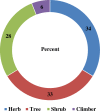Ethnobotanical study of medicinal plants in the Hawassa Zuria District, Sidama zone, Southern Ethiopia
- PMID: 31126296
- PMCID: PMC6534827
- DOI: 10.1186/s13002-019-0302-7
Ethnobotanical study of medicinal plants in the Hawassa Zuria District, Sidama zone, Southern Ethiopia
Abstract
Background: Ethiopia is one of the species-rich countries in the world and the center of origin with regard to the diversity of many plant species. Ethnobotanical studies are vital to investigate these diverse biological resources for medicinal purposes. The aim of this study was to document the indigenous knowledge of the Sidama people regarding the use of medicinal plants to treat human and livestock diseases in the Hawassa Zuria district of Southern Ethiopia.
Methods: A total of 150 informants (118 men and 32 women) were selected to collect ethnobotanical information from ten kebeles by means of a stratified purposive sampling method. Among the informants, 30 key informants were selected purposefully. Ethnobotanical data were collected through semi-structured interviews and group discussions and were analyzed by descriptive statistics, informant consensus factor (ICF), fidelity level (FL), and ranking methods.
Results: A total of 105 medicinal plants distributed across 52 families and 96 genera were collected. Fabaceae (11 species) was represented by the highest number of plant species, followed by Lamiaceae (7 species). Herbs (34%) were the dominant growth habits, followed by trees (33%). Leaves (56%) were the dominant plant part used in the preparation of remedies, followed by fruit (15%). The most common method of remedy preparation was grinding (39%) followed by chewing and boiling (11% each). Oral (74%) was the major routes of administration, followed by dermal (20%). There was a significant knowledge difference (p < 0.05) between social groups regarding the use of traditional medicinal plants. Insects and ectoparasites disease category (0.95) had higher informant consensus factor value followed by fever disease category (0.91). Eucalyptus globulus Labill. (100%) had a higher fidelity level to treat stomachache, followed by Ensete ventricosum (Welw.) Cheesman. (87.27%) to treat placenta delay. Ensete ventricosum (total score = 73) was ranked highest as the most preferable medicinal plant for various purposes by local people, followed by Olea welwitschii (Knobl.) Gilg (total score = 72).
Conclusion: The present study revealed the existence of indigenous knowledge of medicinal plants to treat human and livestock ailments. However, agricultural expansion, firewood collection, environmental degradation, and deforestation are the main threats to medicinal plants. Therefore, there should be mentoring for the local people in the study area to conserve their indigenous knowledge resources and prevent the extinction of medicinal plants.
Keywords: Ethiopia; Hawassa Zuria district; Medicinal plants; Sidama people; Traditional knowledge.
Conflict of interest statement
The authors declare that they have no competing interests.
Figures









Similar articles
-
Ethnobotanical study of medicinal plants in Ganta Afeshum District, Eastern Zone of Tigray, Northern Ethiopia.J Ethnobiol Ethnomed. 2018 Nov 3;14(1):64. doi: 10.1186/s13002-018-0266-z. J Ethnobiol Ethnomed. 2018. PMID: 30390675 Free PMC article.
-
Ethnobotanical study of medicinal plants used to treat human and livestock ailments in Addi Arkay district, northwest Ethiopia.J Ethnobiol Ethnomed. 2025 May 9;21(1):31. doi: 10.1186/s13002-025-00775-3. J Ethnobiol Ethnomed. 2025. PMID: 40346565 Free PMC article.
-
Medicinal plants used to treat livestock ailments in Ensaro District, North Shewa Zone, Amhara Regional State, Ethiopia.BMC Vet Res. 2022 Jun 22;18(1):235. doi: 10.1186/s12917-022-03320-6. BMC Vet Res. 2022. PMID: 35733153 Free PMC article.
-
An overview on ethnobotanico-pharmacological studies carried out in Morocco, from 1991 to 2015: Systematic review (part 1).J Ethnopharmacol. 2021 Mar 1;267:113200. doi: 10.1016/j.jep.2020.113200. Epub 2020 Aug 1. J Ethnopharmacol. 2021. PMID: 32750461
-
Medicinal plants for gastrointestinal diseases among the Kuki-Chin ethnolinguistic groups across Bangladesh, India, and Myanmar: A comparative and network analysis study.J Ethnopharmacol. 2020 Apr 6;251:112415. doi: 10.1016/j.jep.2019.112415. Epub 2020 Jan 7. J Ethnopharmacol. 2020. PMID: 31917280 Review.
Cited by
-
In vitro antioxidant activity and polyphenolic content of commonly used spices from Ethiopia.Heliyon. 2020 Sep 22;6(9):e05027. doi: 10.1016/j.heliyon.2020.e05027. eCollection 2020 Sep. Heliyon. 2020. PMID: 32995654 Free PMC article.
-
Review of Ethnobotanical and Ethnopharmacological Evidence of Some Ethiopian Medicinal Plants Traditionally Used for Peptic Ulcer Disease Treatment.Clin Exp Gastroenterol. 2022 Sep 24;15:171-187. doi: 10.2147/CEG.S384395. eCollection 2022. Clin Exp Gastroenterol. 2022. PMID: 36186925 Free PMC article. Review.
-
Medicinal Plants Used for the Management of Hepatitis Over the Past 15 Years in Ethiopia: A Systematic Review.Hepat Med. 2023 Mar 9;15:11-19. doi: 10.2147/HMER.S402975. eCollection 2023. Hepat Med. 2023. PMID: 36923368 Free PMC article. Review.
-
Harvesting nature's bounty: exploring the ethnobotanical landscape of wild edible plants in the Awi Agäw community, Northwestern Ethiopia.J Ethnobiol Ethnomed. 2024 May 30;20(1):59. doi: 10.1186/s13002-024-00696-7. J Ethnobiol Ethnomed. 2024. PMID: 38816853 Free PMC article.
-
Medicinal plants used by traditional medicine practitioners in treatment of alcohol-related disorders in Bushenyi District, southwestern Uganda.Front Pharmacol. 2024 Jun 10;15:1407104. doi: 10.3389/fphar.2024.1407104. eCollection 2024. Front Pharmacol. 2024. PMID: 38919256 Free PMC article.
References
-
- WHO. Regulatory situation of herbal medicines. A worldwide review. Geneva: World Health Organization; 1998. p. 1–5.
-
- Lucy H, Edgar JD. Medicinal plants: a reemerging health aid, division of life sciences UNESCO. 1999.
-
- Abebe D. In: The role of medicinal plants in healthcare coverage of Ethiopia, the possible benefits of integration. 6–21 in conservation and sustainable use of medicinal plants in Ethiopia. Zewdu M, Demissie A, editors. Addis Ababa: Institute of Biodiversity Conservation and Research; 2001.
MeSH terms
LinkOut - more resources
Full Text Sources
Medical
Molecular Biology Databases

